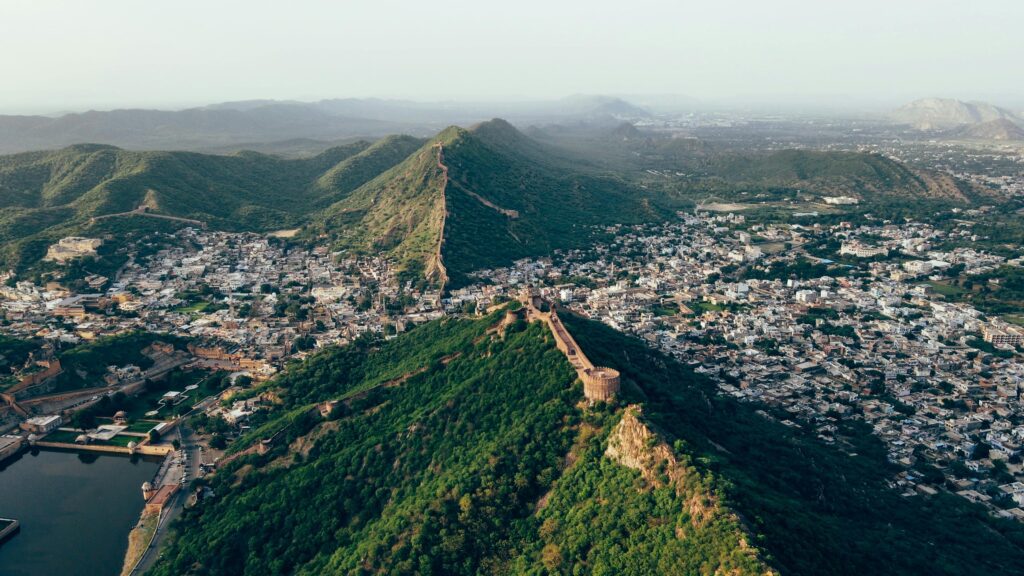
Table of Contents
Introduction
Rajasthan, more popularly known as the “Land of Kings,” is a land where the past comes alive in the shape of beautiful palaces, majestic havelis, and breathtaking forts.
Of these wonders, the Hill Forts of Rajasthan are some gigantic pieces of Rajputana design and courage.
These giant stone houses are not only the leftovers of yesteryears but living histories of courage, resilience, and ingenuity that have shaped India’s political and cultural heritage.
The UNESCO listing of the Hill Forts of Rajasthan in 2013 pushed these places from local treasures to global icons of heritage.
Stretching across the Aravalli and Vindhya mountain ranges, these forts were not merely battleground fortresses—these were bustling cities, centers of culture, and beacons of the invincible Rajput spirit.
For more than a thousand years, they weathered invasions, witnessed sacrifices, and proved architectural masterstrokes unmatched anywhere else in the cosmos.
Now, all these forts are not just architectural wonders but also India’s most sought-after tourist destinations.
One fort is superior to the others in its setting, architecture, and historical prominence, but all of them as a whole speak volumes about Rajasthan’s grandeur. In this blog, we will be talking of the seven UNESCO World Heritage hill forts:
Amer Fort, Chittorgarh Fort, Kumbhalgarh Fort, Ranthambore Fort, Gagron Fort, and Jaisalmer Fort. From these tales, you will journey back to an earlier time filled with courage, splendor, and imagination.
The UNESCO World Heritage Status of Hill Forts
Six Rajasthan Hill Forts were included as UNESCO World Heritage Sites in 2013 for their engineering skills, military significance, and cultural significance.
The inclusion was not according to size or magnitude—it was according to how the forts could reflect a unique type of defensive architecture that is appropriate to the hilly terrain of Rajasthan.
These forts—Amer, Chittorgarh, Kumbhalgarh, Ranthambore, Gagron, and Jaisalmer—al together symbolize the military might and wisdom of the Rajput kingdoms of the 8th to 18th centuries.
UNESCO noted their distinctive building technique, blending with natural topography, and ability to withstand prolonged sieges.
Contrary to other Indian forts, which were usually remote buildings, these were gigantic complexes housing palaces, temples, water tanks, and entire communities within the huge walls.
The UNESCO Hill Forts Rajasthan inscription emphasizes three key standards:
Military Architecture: They show advanced techniques in fortification, including high stone walls, bastions, gates, and strategic positions on hills.
Cultural Exchange: The forts reflect a combination of Rajput and Mughal styles, showing centuries of cross-cultural exchange.
Living Heritage: Some forts, like Jaisalmer, continue to be inhabited, preserving traditional lifestyles within their walls.
For modern-day travelers, these forts are not merely travel destinations—they are permanent sun-and-star museums, telling volumes about war, dynasties, and survival.
Amer Fort, Jaipur – The Dazzling Gateway to Rajasthan’s Royalty
Mounted regally upon the Aravalli hills and looking down over the lake of Maota, Amer Fort is one of the most desirable Hill Forts of Rajasthan.
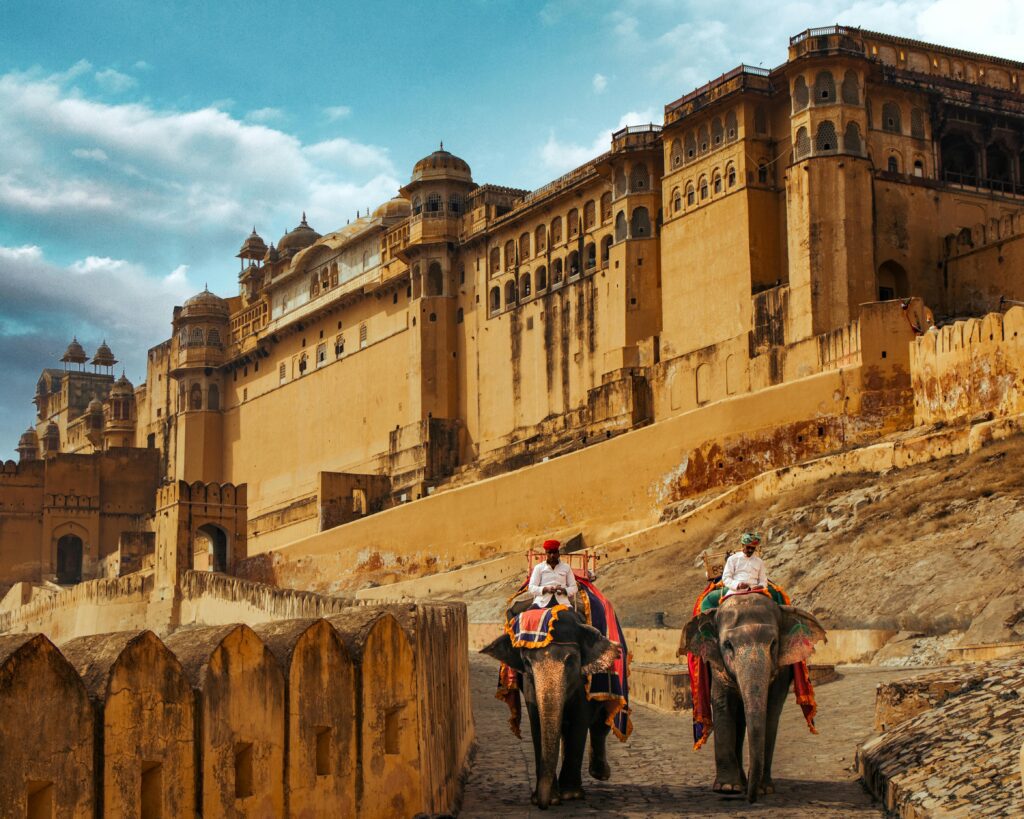
Built in 1592 by Raja Man Singh I and later expanded upon by successive rulers, Amer Fort is a synthesis of Rajput and Mughal school of thought.
With its elaborate gateways, sweeping courtyards, and intricately crafted mirror work, Amer is the perfection of Rajput artistic achievement.
Architecture and Highlights
The fort consists of marble and red sandstone and possesses a rugged exterior that conceals the lavish interiors.
The visitors arrive through the grand Suraj Pol (Gate of the Sun), which leads to courtyards reverberating with history.
The Diwan-i-Aam (Hall of Public Audience), the Ganesh Pol entrance adorned with frescoes, and the magnificent Sheesh Mahal (Mirror Palace) are architectural marvels that tell volumes about the splendor of Rajputana life.
Historical Significance
Amer Fort, also known as Amber Fort, was commissioned in 1592 by Raja Man Singh I, one of the most trusted generals in Emperor Akbar’s court.
Over the centuries, successive rulers of the Kachwaha dynasty expanded and beautified the fort.
Before Jaipur was established as the capital in the 18th century, Amer served as the political and cultural center of the region.
The fort’s hilltop location was strategic—it not only provided defense against invasions but also symbolized the strength and authority of the Rajput rulers.
Its inclusion in the UNESCO Hill Forts Rajasthan list highlights its dual role as both a military stronghold and a royal residence filled with grandeur.
UNESCO Recognition
Amer’s choice as one of the UNESCO Hill Forts Rajasthan derives from its architectural brilliance and cultural importance.
It is a witness to the glory of Jaipur’s royal heritage and remains a must-see among the tourist spots of Rajasthan.
Legacy of Amer Fort
Amer Fort stands as a proud reminder of Rajasthan’s rich heritage. It represents the artistry, valor, and grandeur that define the Hill Forts of Rajasthan.
As both a historical monument and a living cultural space, Amer Fort continues to inspire awe in all who walk through its grand gateways and intricately decorated halls.
Chittorgarh Fort, Chittorgarh – India’s largest fort
If Amer represents sophistication, Chittorgarh represents rebellion. Taking up nearly 700 acres of land and perched atop a hill, Chittorgarh Fort is India’s largest fort and possibly the most legendary of the Rajasthan Hill Forts.
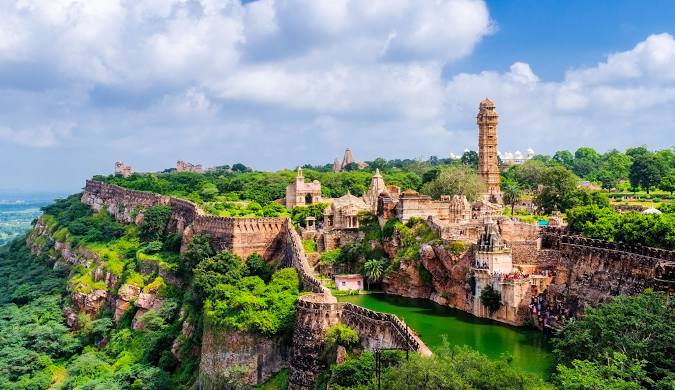
Built in the 7th century, it was declared the capital of Mewar by the Guhila and Sisodia dynasties.
History of Valor
Chittorgarh’s origins trace back to the 7th century, when it was built by the Maurya dynasty. However, it rose to prominence under the Sisodia Rajputs of Mewar, who made it their capital in the 8th century.
For centuries, Chittorgarh remained the seat of Mewar’s power and the symbol of Rajput resistance against successive invaders.
The fort is particularly associated with legendary rulers and heroines such as Rana Kumbha, Rana Sanga, Maharana Pratap, Rani Padmini, and Rani Karnavati.
Each left an indelible mark on the fort’s history, making Chittorgarh not just an architectural marvel but also a living saga of Rajputana pride.
Architectural Wonders
The fort houses various palaces, temples, and towers. The Vijay Stambh (Victory Tower), built by Rana Kumbha in the 15th century, is a victory symbol.
The Kirti Stambh (Tower of Fame) dedicated to Jain Tirthankara Adinath is another architectural wonder. The fort also houses grand gates like Ram Pol and Padan Pol, besides reservoirs which offered life during sieges.
Cultural Importance
For Rajasthan, Chittorgarh is not just a fort—it is a temple of sacrifice and valour. Its status as a UNESCO site testifies to its unique place in establishing the Rajput identity. It is now among India’s most emotionally moving tourist attractions.
Legacy of Chittorgarh
Chittorgarh is not just a fort; it is a legend carved in stone. Its tales of bravery, sacrifices of queens, and immortal devotion of Meera Bai continue to inspire generations.
As the largest and most celebrated of the Hill Forts of Rajasthan, Chittorgarh Fort stands as the eternal flame of Rajput pride and resilience, ensuring its place as one of the most iconic tourist destinations in the world.
Kumbhalgarh Fort, Rajsamand – The Great Wall of India
Located in the Aravalli hills, Kumbhalgarh Fort is another treasure of Rajasthan’s Hill Forts.
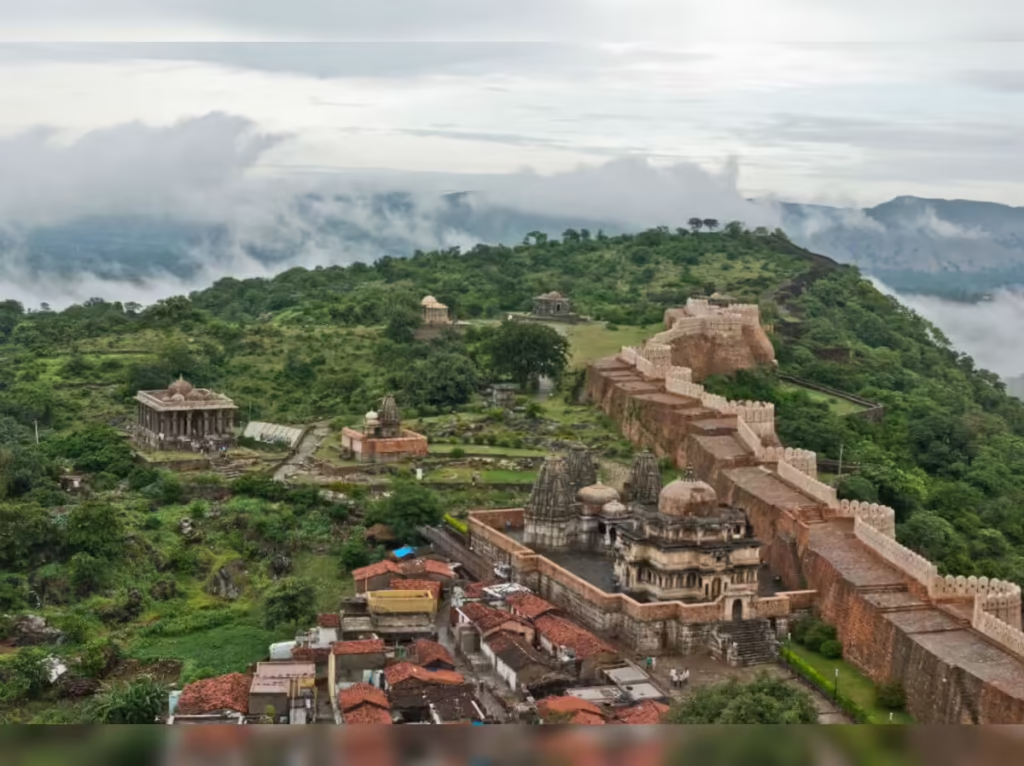
Built by Rana Kumbha in the 15th century, it is famous for having a 36-kilometer-long wall, the second-longest unbroken wall in the world after the Great Wall of China.
This engineering feat makes Kumbhalgarh one of India’s most offbeat tourist spots.
Strategic Architecture
The fact that the fort is at 1,100 meters above sea level made it nearly unconquerable.
Having seven massive gates, 360 temples, and intricately built palaces, Kumbhalgarh is the proof of Rajput architectural prowess. Badal Mahal, located on the highest point of the fort, offers breathtaking views of the surrounding hills.
Historical Role
Kumbhalgarh Fort was built in the 15th century by the great Rana Kumbha, the ruler of Mewar, after whom it is named.
Rana Kumbha was a patron of art, architecture, and learning, and under his rule, Mewar saw an era of cultural and architectural prosperity.
Out of the 84 forts said to have been commissioned by him, Kumbhalgarh was the most formidable and strategically important.
The fort was constructed between 1443 and 1458 CE and became the second capital of the kingdom of Mewar, providing refuge to the rulers whenever the main capital, Chittorgarh, came under siege.
Most notably, it was also the birthplace of the legendary Rajput warrior Maharana Pratap, who later became the most celebrated hero of Mewar.
UNESCO Recognition
The strategic hilltop position of the fort, massive walls, and its architectural brilliance assisted it in becoming included in the list of UNESCO Hill Forts Rajasthan. Surrounded by the Kumbhalgarh Wildlife Sanctuary, it offers an unusual blend of history and nature and thus a unique tourist spot.
Ranthambore Fort, Sawai Madhopur – The Royal Legacy Amidst the Jungle
Deep within the Ranthambore National Park lies the magnificent Ranthambore Fort. This is unlike the other Hill Forts of Rajasthan in that it stands out prominently with its admixture of heritage and nature.
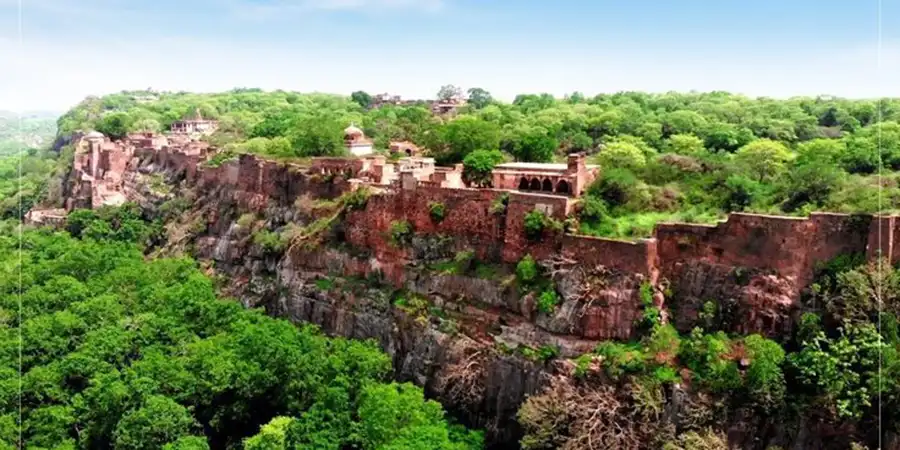
The fort was built in the 10th century by the Chauhan dynasty rulers to act as a crucial defense system of the region.
Architectural Layout
The huge complex of the fort consists of palaces, temples, and stepwells. The tall walls and massive doors are a sign of military strength. Ganesha, Shiva, and Ramlalji temples make the fort a defensive fortress as well as a sacred site.
Historical Importance
Ranthambhore Fort has a layered history stretching back nearly a thousand years. Though exact origins are debated, most historians attribute its construction to the Chauhan rulers in the 10th century, with major expansions carried out by Raja Sajraj Chauhan and later by Rao Hammir Deo Chauhan in the 13th century.
The fort became the center of Chauhan power until the late 13th century, with Hammir Deo Chauhan being its most famous ruler.
His defiance against the Sultan of Delhi, Alauddin Khilji, is one of the most celebrated episodes in Rajput history.
The fort witnessed many battles, sieges, and acts of courage, standing as a resilient stronghold of Rajputana pride.
Over time, Ranthambhore came under the control of the Delhi Sultanate, Mughals, and later the rulers of Jaipur. Despite frequent changes in power, it never lost its significance as a military bastion and a cultural landmark among the Hill Forts of Rajasthan.
Tourism and Wildlife
Now Ranthambore Fort comes under a very frequented place because the fort is toured by the tourists, along with the adjacent tiger reserve. The combination of heritage and wildlife here makes it stand among the most unique Hill Forts of Rajasthan.
Gagron Fort, Jhalawar – The Water Fort
Gagron Fort is exceptional among the Hill Forts of Rajasthan because of its natural position.

Surrounded by waters of the rivers Ahu and Kali Sindh and bounded by the Mukundara hills, it is one of India’s few water forts.
Architectural Style
Whereas Amer or Chittorgarh boasts palaces of grandeur, Gagron Fort is austere, exuding defensive solidity. Its twin fort and strategic location made it impossible to conquer for centuries.
Historical Background
Gagron Fort has a rich history that stretches back to the 12th century. It was built by the Parmara dynasty and later came under the control of the Khinchi rulers, who made it their stronghold.
For nearly three centuries, the fort was a witness to numerous battles, heroic defenses, and tragic sacrifices.
Its strategic location at the confluence of the Ahu and Kalisindh rivers made it extremely difficult to besiege, giving it an advantage over other Rajput forts.
However, its history is also marked by invasions from powerful adversaries like the Delhi Sultans and the Mughals, against whom the Rajputs of Gagron fought with unmatched bravery.
Cultural Value
The fort conducts fairs and religious events annually, blending history with living culture. Its status as a UNESCO Hill Forts Rajasthan underlines its natural and man-made defense combination.
Jaisalmer Fort, Jaisalmer – The Living Golden Fort
Emerging out of Thar Desert sands, Jaisalmer Fort is one of a kind. It is called Sonar Quila (Golden Fort) and shines under the desert sun because of its yellow sandstone building.

Constructed in 1156 by Rawal Jaisal, the fort is even today occupied by people, thus being a “living fort.”
Unique Features
It contains four grand gateways and is enclosed by enormous walls. Inside, it has temples, palaces, and bustling bazaars where inhabitants live and labor to this day. Its cobblestone streets echo with history, and its elevation offers stunning vistas of the desert.
Historical Role
Jaisalmer Fort was built in 1156 CE by Rawal Jaisal, a Bhati Rajput ruler, who shifted his capital from Lodurva to this new fort for strategic security.
Rising dramatically from the desert landscape, the fort quickly became a major hub on the Silk Route, connecting India with Central Asia, Persia, and beyond.
Throughout history, Jaisalmer Fort faced numerous attacks, particularly from the Delhi Sultanate and later the Mughals.
However, its desert location and formidable defenses ensured that it remained a resilient stronghold.
The Bhati Rajputs, known for their bravery, turned the fort into both a military bastion and a thriving trade center, blending martial valor with economic prosperity.
Living Heritage
As one of the most offbeat tourist attractions, Jaisalmer Fort remains alive with culture, tradition, and everyday life. Its listing as part of the UNESCO Hill Forts Rajasthan underlines the intersection of heritage and modernity.
General Significance of Rajasthan’s Hill Forts
The Rajput Hill Forts collectively represent the Rajput temperament—bravery, vigour, and workmanship.
All the forts have their own distinct story to tell, but collectively they tell a history unmatched in India. They represent the Rajput principle of defending honour no matter what and as well-being places for art, religion, and governance.
As tourist attractions, the forts receive the world’s tourists. From Amer’s sparkling interiors to Jaisalmer’s desert radiance, they offer a diverse experience that captures the essence of Rajasthan.
Being a World Heritage Centre ensures that they remain untouched so that future generations get to witness this spectacular heritage.
Conclusion
The Hill Forts of Rajasthan are more than just stone fortifications; they are living monuments that embody the soul of Rajputana valor, resilience, and cultural brilliance.
Recognized globally as part of the UNESCO Hill Forts Rajasthan, these six architectural marvels—Amer, Chittorgarh, Kumbhalgarh, Ranthambore, Gagron, and Jaisalmer—stand as timeless testaments to India’s glorious past.
Each fort narrates a unique chapter of history: Amer’s royal elegance, Chittorgarh’s legendary tales of sacrifice, Kumbhalgarh’s impregnable walls, Ranthambore’s fusion of heritage and wilderness, Gagron’s unique water fortification, and Jaisalmer’s golden living legacy.
Together, they represent the perfect blend of military strategy, architectural innovation, and cultural richness.
Beyond their grandeur, these forts continue to inspire generations by reflecting the unshakable pride and honor of the Rajputs.
They are not only heritage treasures but also iconic tourist destinations that attract travelers from around the globe.
Exploring them offers more than sightseeing—it provides an immersion into centuries of history, art, and tradition that define Rajasthan’s identity.
The preservation of the Hill Forts of Rajasthan under UNESCO ensures that these monuments will remain eternal guardians of India’s heritage.
For history enthusiasts, culture seekers, and travelers alike, they are enduring symbols of courage and creativity, standing tall against the passage of time.
